Healthy Swaps for Your Favorite Unhealthy Foods: Tasty, Guilt-Free Alternatives That Work
Craving Without the Guilt?
Let’s be real, we all have those go-to comfort foods. You know the ones, crispy french fries, creamy mac and cheese, sugary pastries, or a late-night slice of pizza. They taste amazing until they don’t anymore, when you’re bloated, sluggish, or just plain regretful after indulging.
But what if you could enjoy all your favorites, minus the guilt? That’s where healthy swaps for your favorite unhealthy foods come in. These aren’t about deprivation or bland salads. They’re about making smarter choices that still hit the spot, nourish your body, and keep your cravings at bay.
Whether you’re trying to lose weight, boost energy, or just eat cleaner, this guide is packed with expert-backed, mouthwatering swaps that work. No fluff, no fads, just real food, done right.
Also read – Best Exercises to Boost Your Metabolism

What Are Healthy Swaps?
Think of healthy swaps like a culinary remix. It’s not about cutting out everything you love, it’s about upgrading the ingredients or prep methods to make them more nutritious, satisfying, and sustainable for your health goals.
For example:
- Swap white bread for whole grain.
- Use Greek yogurt instead of sour cream.
- Try baked sweet potato fries over regular fries.
It’s simple math, fewer empty calories, more nutrients, same satisfaction.
Why This Matters
According to the Centers for Disease Control and Prevention (CDC), the prevalence of obesity among U.S. adults was 40.3% during August 2021–August 2023, close to the nearly 42% mentioned for 2023–2024. Obesity is strongly associated with preventable conditions like heart disease, stroke, and type 2 diabetes. However Research, including a 2024 review in Current Nutrition Reports, indicates that reducing ultra-processed food intake and replacing it with minimally processed foods can help lower obesity risk. While studies show benefits from such swaps, like choosing nuts or whole grain crackers over packaged snacks.
And let’s not forget, food is emotional. Trying to cut out your favorite treats completely often backfires, leading to binges or burnout. Smart swaps help you stay on track without feeling deprived.
Making small changes, such as swapping sugary drinks for water or processed snacks for fruits, can improve nutrition without deprivation, supported by evidence from dietary studies.
Empowering Choices Through Technology
Tools like the Yuka app are revolutionizing how we approach food choices. By scanning product barcodes, users receive health-based scores, helping them make informed decisions and encouraging manufacturers to improve product formulations.
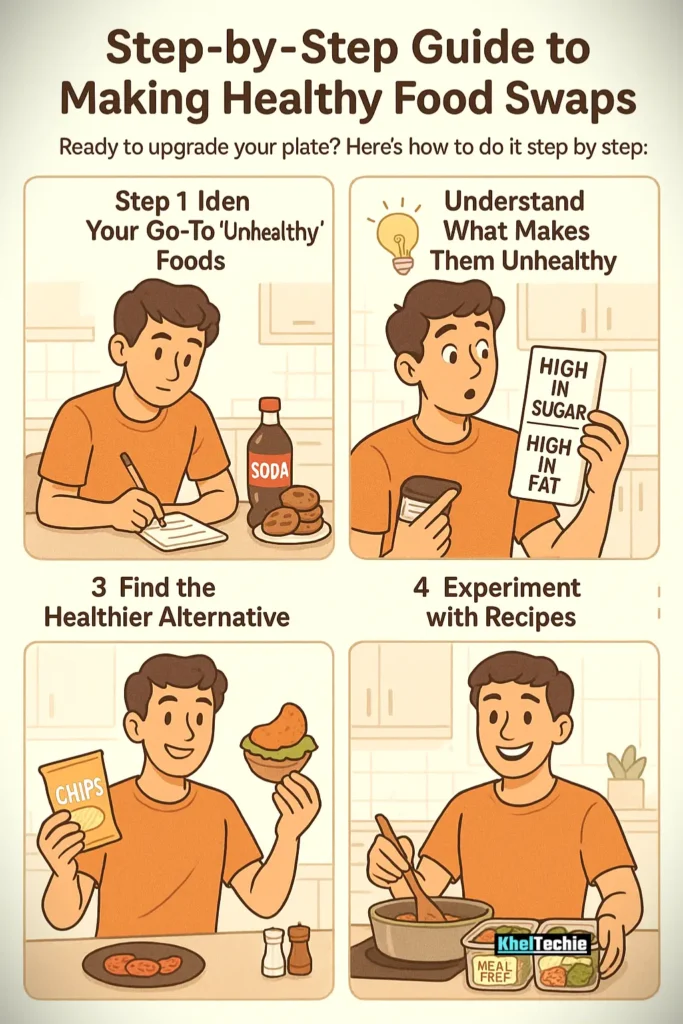
Step-by-Step Guide to Making Healthy Food Swaps
Ready to upgrade your plate? Here’s how to do it step by step:
Step 1: Identify Your Go-To Unhealthy Foods
Start by listing the foods you crave most. Is it pizza? Ice cream? Fried chicken? Soda? Once you’ve got your list, you’re ready for the fun part.
Step 2: Understand What Makes Them Unhealthy
Is it the oil? The sugar? The refined carbs? Knowing the culprit helps you find the best swap. For instance:
- Fries = fried + starch-heavy → swap with baked sweet potato wedges
- Ice cream = high sugar + saturated fat → swap with frozen banana soft serve
Step 3: Find the Healthier Alternative
Use these criteria:
- Lower in added sugars
- Higher in fiber and protein
- Rich in healthy fats
- Less processed
Here’s a handy table to get started:
| Unhealthy Food | Healthy Swap | Benefits |
|---|---|---|
| White Rice | Cauliflower Rice | Low-carb, high-fiber, gluten-free |
| Cheeseburgers | Turkey Burgers | Leaner protein, less saturated fat |
| Milk Chocolate | Dark Chocolate (70%+) | Antioxidants, less sugar |
| Sugary Cereal | Oatmeal with Berries | Whole grain, natural sweetness |
| Soda | Sparkling Water with Fruit | Zero sugar, refreshing |
Step 4: Experiment with Recipes
Don’t just substitute, elevate! Try making:
- Zucchini lasagna instead of traditional pasta layers
- Chickpea tuna salad instead of canned tuna
- Avocado toast with egg instead of buttered toast
Step 5: Make It Sustainable
This isn’t a quick fix, it’s a lifestyle shift. Focus on progress, not perfection. Aim for 80/20: 80% nutrient-dense meals, 20% room for indulgence.
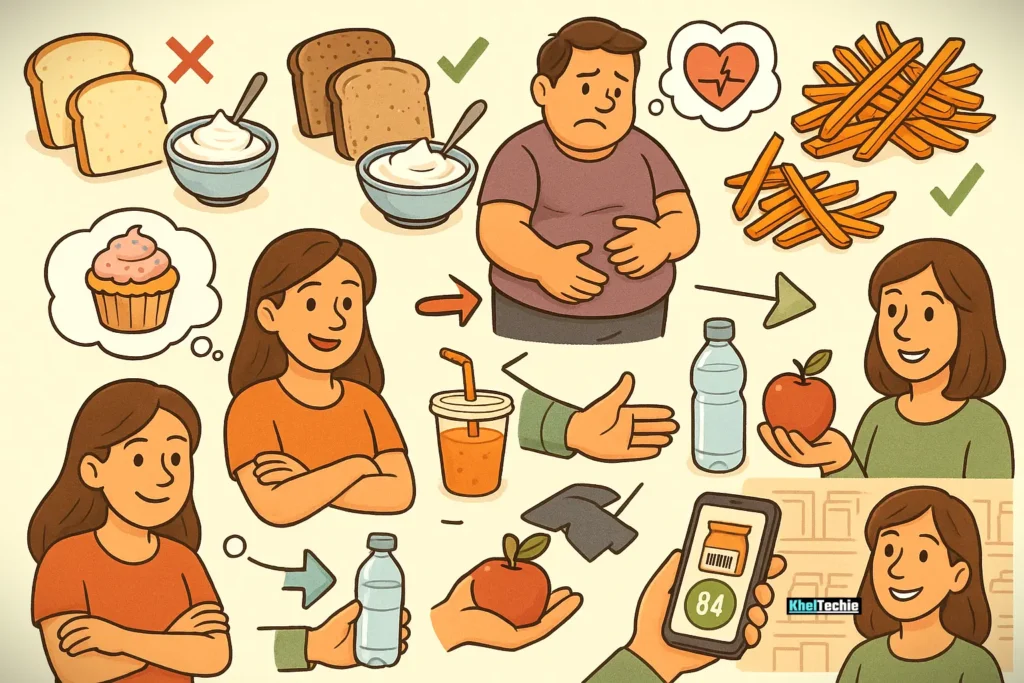
Common Mistakes to Avoid When Making Healthy Swaps
Even with the best intentions, it’s easy to fall into traps. Here are some common mistakes, and how to avoid them:
❌ Assuming “Low-Fat” Means Healthier
Many low-fat products replace fat with added sugars or artificial thickeners. Always check the label. Sometimes full-fat versions (like Greek yogurt or nut butters) are better in moderation.
❌ Overloading on “Healthy” Calories
Just because something is organic or gluten-free doesn’t mean it’s low-calorie. Nuts, dried fruit, oils, they’re healthy but calorie-dense. Portion control still matters.
❌ Skipping Protein
Swapping a burger for a veggie patty won’t satisfy hunger unless you add protein. Pair with beans, tofu, eggs, or lean meat substitutes.
❌ Not Seasoning Enough
Healthy food can be boring if you don’t spice it up. Use herbs, spices, lemon juice, vinegars, and hot sauces to enhance flavor without adding calories.
❌ Giving Up Too Soon
Change takes time. Don’t expect to love every swap right away. Keep experimenting until you find what works for your palate.
Healthy Swaps for Your Favorite Unhealthy Foods Real Examples
Now let’s dive into the fun stuff, actual food swaps you can try today!
1. French Fries → Baked Sweet Potato Fries
Why it works: Sweet potatoes are rich in fiber, beta-carotene, and potassium. Baking cuts down on unhealthy fats.
How to make it:
- Cut sweet potatoes into strips
- Toss with olive oil, paprika, garlic powder
- Bake at 425°F (220°C) for 20–25 minutes
Dip in Greek yogurt mixed with dill or sriracha for a healthier ranch alternative.
2. Ice Cream → Frozen Banana Soft Serve
Why it works: Bananas provide natural sweetness, potassium, and fiber. Add peanut butter or berries for extra flavor and nutrients.
How to make it:
- Freeze ripe bananas
- Blend in a food processor until smooth
- Add cocoa powder, vanilla extract, or cinnamon
Top with crushed nuts or dark chocolate shavings for crunch.
3. Pizza → Cauliflower Crust Pizza
Why it works: Lower in carbs and calories than traditional crust, plus it adds veggies to your meal.
How to make it:
- Buy or make cauliflower crust
- Add tomato sauce, mozzarella, veggies, and lean protein
- Bake until bubbly
Use zucchini slices as a base for mini pizzas for a fun appetizer twist.
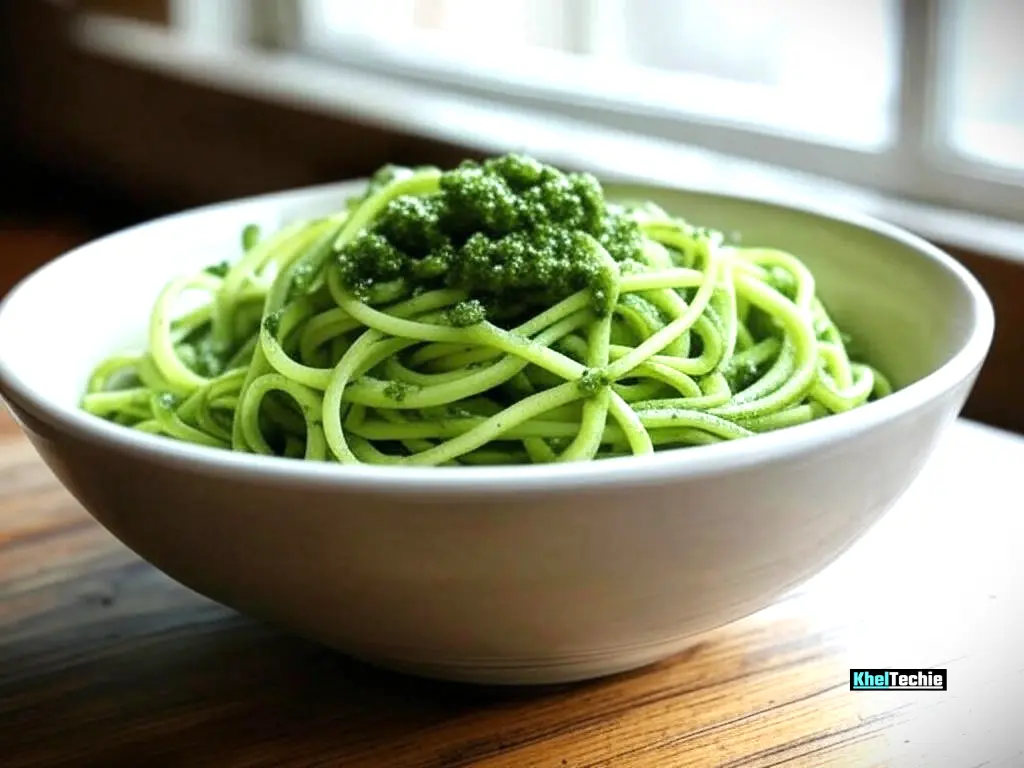
4. Pasta → Zucchini Noodles (Zoodles)
Why it works: Zucchini is low in calories, high in water content, and loaded with vitamins.
How to make it:
- Spiralize zucchini
- Sauté for 2–3 minutes to remove moisture
- Toss with pesto, marinara, or avocado sauce
Mix zoodles with regular pasta for a gradual transition.
5. Chips → Kale Chips
Why it works: Kale is a superfood packed with antioxidants, iron, and vitamin K.
How to make it:
- Tear kale leaves into bite-sized pieces
- Toss with olive oil, salt, nutritional yeast
- Bake at 300°F (150°C) for 15–20 minutes
Add chili flakes or Parmesan for a spicy/savory kick.
6. Sandwiches → Lettuce Wraps
Why it works: Eliminates bread entirely while keeping the sandwich experience.
How to make it:
- Use large lettuce leaves (romaine, butter lettuce)
- Fill with grilled chicken, turkey, hummus, or tuna
- Add tomatoes, cucumbers, sprouts
Wrap in foil for a portable lunch option.
7. Mac and Cheese → Butternut Squash Mac
Why it works: Butternut squash adds creaminess and color without dairy.
How to make it:
- Roast butternut squash
- Blend with nutritional yeast, garlic, almond milk
- Toss with whole wheat pasta
Add steamed broccoli or spinach for extra fiber.
8. Granola Bars → Homemade Energy Bites
Why it works: Store-bought bars are often loaded with sugar. DIY bites use oats, nuts, and natural sweeteners.
How to make it:
- Mix oats, peanut butter, honey, chia seeds
- Roll into balls
- Refrigerate for 30 minutes
Add shredded coconut, mini chocolate chips, or raisins for variety.
9. Cookies → Oatmeal Cookie Dough Bites
Why it works: Uses oats, nut butter, and maple syrup for a healthier treat.
How to make it:
- Combine oats, almond butter, maple syrup, vanilla
- Roll into small balls
- Chill before eating
Add mini dark chocolate chunks for extra indulgence.
10. Chicken Nuggets → Baked Coconut Chicken Tenders
Why it works: Coating chicken in shredded coconut adds flavor and texture without frying.
How to make it:
- Dip chicken strips in egg, then coat with coconut flakes
- Bake at 400°F (200°C) for 15–20 minutes
Serve with a side of mango salsa or Greek yogurt dip.
Also read – High-Protein Breakfast Ideas for Busy Mornings
Final Thoughts: Eat Well, Live Better
Making healthy swaps for your favorite unhealthy foods isn’t about restriction, it’s about evolution. It’s about finding joy in food that also fuels your body, boosts your energy, and keeps you feeling great.
You don’t need to overhaul your entire diet overnight. Start small. Pick one swap this week. Then another next week. Before you know it, you’ll be eating healthier without even thinking about it.
📣 Want More Healthy Tips?
If you found these healthy swaps helpful, drop a comment below and share your favorite recipe or swap! And don’t forget to pin this post for future reference or share it with someone who loves food as much as you do.
Let’s make eating well easier, tastier, and totally doable, together.
FAQs
Can I Still Enjoy My Favorite Foods on a Diet?
Yes! That’s the beauty of healthy swaps. By choosing better ingredients and cooking methods, you can enjoy the flavors you love without the negative effects.
Are Healthy Swaps Expensive?
Not necessarily. Many swaps use affordable staples like beans, lentils, oats, and seasonal produce. Buying in bulk and planning meals ahead can also save money.
Do Healthy Swaps Really Help with Weight Loss?
Absolutely — especially when paired with portion control and balanced meals. Replacing calorie-dense, nutrient-poor foods with whole, minimally processed options supports long-term weight management.
How Do I Know If a Swap Is Actually Healthier?
Check the nutrition label. Look for:
- Lower sodium and added sugars
- Higher fiber and protein
- Fewer artificial ingredients
Also, choose whole foods over packaged alternatives whenever possible.
Can Kids Eat These Healthy Swaps?
Definitely! In fact, introducing kids to healthy swaps early sets them up for lifelong healthy habits. Start with kid-friendly swaps like:
- Hidden veggie spaghetti sauce
- Apple slices with almond butter
- Mini quinoa muffins
Will Healthy Swaps Taste Good?
With the right seasonings and preparation, absolutely! Don’t underestimate the power of herbs, spices, citrus, and healthy fats like avocado or olive oil.
What If I Miss the Original Version?
That’s okay! Start by mixing half original and half swap version. Gradually increase the ratio as your taste buds adapt.
How Often Should I Make Healthy Swaps?
Aim for consistency, not perfection. Even swapping one or two meals a day makes a difference. Remember the 80/20 rule: 80% healthy, 20% flexibility.
Where Can I Find Healthy Swap Recipes?
Great question! Try:
- Cooking blogs like Minimalist Baker or Oh She Glows
- Apps like Yummly or MyFitnessPal
- Pinterest boards focused on healthy eating
Also, look for cookbooks that specialize in plant-based or clean-eating recipes.
Can I Eat Out and Still Make Healthy Swaps?
Of course! When dining out:
Ask for dressings and sauces on the side
Choose grilled over fried
Swap fries for a side salad or steamed vegetables
Opt for whole grains like brown rice or quinoa

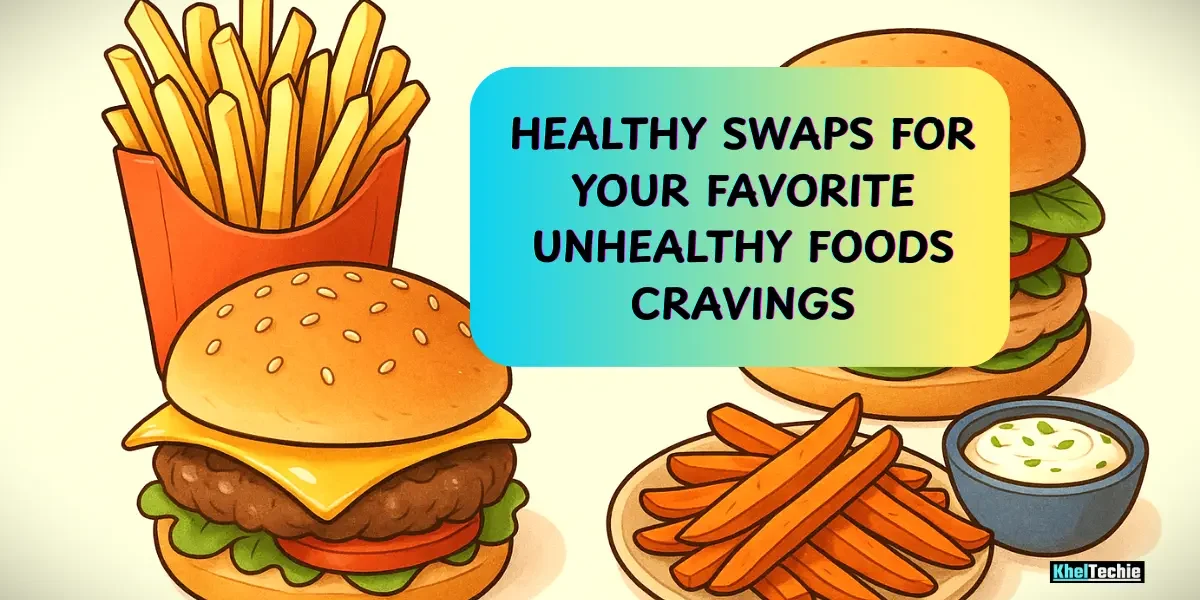

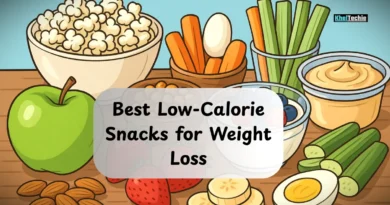
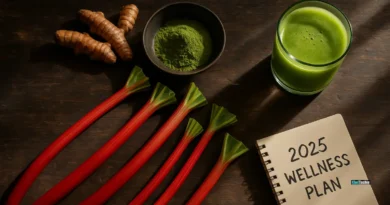
Pingback: How To Avoid Hidden Sugars In Foods: Smart Eating Guide
Pingback: How To Eat Healthy On A Budget In The US|Smart Hacks
Pingback: 15 Natural Ways To Boost Energy And Motivation